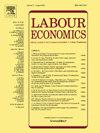德国职业技术培训市场的申请人构成、不匹配和匹配效率
IF 2.6
2区 经济学
Q2 ECONOMICS
引用次数: 0
摘要
2010年代,德国企业职业教育和培训(VET)的入学率停滞不前,2019年至2020年期间下降了11%,这可能会加剧未来技术工人的短缺。在此背景下,我们通过2013年至2021年间按地区级别估计职业的匹配函数来研究VET市场。我们采用了一种新颖的策略,利用不同职业的当地劳动力市场条件的差异,为申请人和职位空缺提供工具。我们估计申请人和职位空缺的匹配弹性分别为0.46和0.57。新冠肺炎前匹配效率略有下降,新冠肺炎后匹配效率下降幅度较大。使用我们的估计来分解匹配的总体趋势,我们发现,虽然匹配效率和申请人在Covid之前推动了匹配率的下降,但直到2019年空缺的增加稳定了VET市场。在新冠疫情期间,申请人数、职位空缺和匹配效率的下降同样导致了匹配率的突然下降。此外,如果没有申请VET职位的移民人数的增加,仅人口结构的变化就会导致Covid之前匹配率的更大下降。职业和地区不匹配的变化几乎不能解释匹配的总体趋势。本文章由计算机程序翻译,如有差异,请以英文原文为准。
The composition of applicants, mismatch, and matching efficiency in the German VET market
Entries into firm-based vocational education and training (VET) stagnated in Germany during the 2010s and decreased by 11% between 2019 and 2020, which is likely to exacerbate future shortages of skilled workers. Against this backdrop, we study the VET market through the lens of a matching function estimated at the occupation by district level between 2013 and 2021. We employ a novel strategy to instrument for applicants and vacancies which draws on differences in local labor market conditions for different occupations. Our estimated matching elasticities for applicants and vacancies are 0.46 and 0.57, respectively. Matching efficiency shows a slight downward trend before Covid and a large drop during Covid. Using our estimates to decompose aggregate trends in matches, we find that while matching efficiency and applicants drove matches down before Covid, the increase in vacancies until 2019 stabilized the VET market. During Covid, the drop in applicants, vacancies, and matching efficiency contributed similarly to the sudden drop of matches. Furthermore, without the increase in migrants applying to VET positions, demographic change alone would have led to an even greater decline in matches already before Covid. Changes in occupational and regional mismatch did little in explaining the overall trend in matches.
求助全文
通过发布文献求助,成功后即可免费获取论文全文。
去求助
来源期刊

Labour Economics
ECONOMICS-
CiteScore
3.60
自引率
8.30%
发文量
142
期刊介绍:
Labour Economics is devoted to publishing research in the field of labour economics both on the microeconomic and on the macroeconomic level, in a balanced mix of theory, empirical testing and policy applications. It gives due recognition to analysis and explanation of institutional arrangements of national labour markets and the impact of these institutions on labour market outcomes.
 求助内容:
求助内容: 应助结果提醒方式:
应助结果提醒方式:


